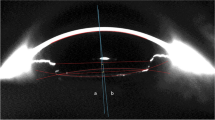Abstract
Background
To evaluate long-term intraocular lens (IOL) decentration and tilt in eyes with pseudoexfoliation syndrome (PES) following cataract surgery using Visante anterior segment OCT and iTrace Visual Function Analyzer.
Methods
Sixty-four eyes following cataract surgery from 2009 to 2012 were included, 34 eyes had PES and 30 eyes did not show PES. A standard phacoemulsification procedure followed by IOL implantation was performed and patients were followed 4–6 years after surgery (mean = 69 months). Best-corrected visual acuity (BCVA), capsulorhexis size, and intraocular pressure (IOP) were measured. IOL decentration and IOL tilt were evaluated using Visante Omni anterior segment OCT (Carl Zeiss Jena GmBH, Germany). The iTrace VFA (Visual Function Analyzer, Hoya surgical optics) was used to measure corneal, internal, and total optical aberrations.
Results
Measurements with iTrace showed that horizontal coma was significantly different between PES and control eyes (p = 0.037). Horizontal as well as vertical tilt showed a significant difference between PES and control eyes (p = 0.035 and p = 0.039). Tilt correlated with capsulorhexis size in PES patients (p = 0.011). This indicates a forward tilt of the superior edge of the IOL in eyes with PES.
Conclusions
Patients affected by PES seem to have a higher risk for long-term complications and changes in visual perception due to IOL tilt and decentration after cataract surgery.


Similar content being viewed by others
References
Lee CM, Afshari NA (2017) The global state of cataract blindness. Curr Opin Ophthol 28:98–103
Drolsum L, Haaskjold E, Davanger M (1993) Pseudoexfoliation syndrome and extracapsular cataract extraction. Acta Ophthalmol 71:765–770
Ostern AE, Sandvik GF, Drolsum L (2014) Positioning of the posterior intraocular lens in the longer term following cataract surgery in eyes with and without pseudoexfoliation syndrome. J Acta Ophthalmol 92:253–258
Vazquez-Ferreiro P, Carrera-Hueso FJ, Fikri-Benbrahim N, Barreiro-Rodriguez L, Diaz-Rey M, Ramón Barrios MA (2017) Intraocular lens dislocation in pseudoexfoliation: a systematic review and meta-analysis. Acta Ophthalmol 95:e164–e169
Shingleton BJ, Heltzer J, O’Donoghue MW (2003) Outcomes of phacoemulsification in patients with and without pseudoexfoliation syndrome. J Cataract Refract Surg 29:1080–1086
Drolsum L, Haaskjold E, Sandvig K (1998) Phacoemulsification in eyes with pseudoexfoliation. J Cataract Refract Surg 24(6):787–792
Kumar DA, Agarwal A, Prakash JS, Saravanan Y, Agarwal A (2011) Evaluation of intraocular lens tilt with anterior segment optical coherence tomography. Am J Ophthalmol 151:406–412
Bessho K, Bartsch DU, Gomez L, Cheng L, Koh HJ, Freeman WR (2009) Ocular wavefront aberrations in patients with macular diseases. Retina 29(9):1356–1363
Jun I, Choi YJ, Kim EK, Seo KY, Kim TI (2012) Internal spherical aberration by ray tracing-type aberrometry in multifocal pseudophakic eyes. Eye (Lond) 26(9):1243–1248
Piñero DP, Sánchez-Pérez PJ, Alió JL (2011) Repeatability of measurements obtained with a ray tracing aberrometer. Optom Vis Sci 88(9):1099–1105
Visser N, Berendschot TT, Verbakel F, Tan AN, de Brabander J, Nuijts RM (2011) Evaluation of the comparability and repeatability of four wavefront aberrometers. Invest Ophthalmol Vis Sci 52(3):1302–1311
Vazquez-Ferreiro P, Carrera-Hueso FJ, Poquet Jornet JE, Fikri-Benbrahim N, Diaz-Rey M, Sanjuan-Cerveró R (2016) Intraoperative complications of phacoemulsification in pseudoexfoliation: metaanalysis. J Cataract Refract Surg 42(11):1666–1675
Hayashi H, Hayashi K, Nakao F, Hayashi F (1998) Anterior capsule contraction and intraocular lens dislocation in eyes with pseudoexfoliation syndrome. Br J Ophthalmol 82:1429–1432
Davison JA (1993) Capsule contraction syndrome. J Cataract Refract Surg 19:582–589
Fallah Tafti MR, Abdollah Beiki H, Mohammadi SF, Latifi G, Ashrafi E, Fallah Tafti Z (2017) Anterior chamber depth change following cataract surgery in pseudoexfoliation syndrome; a preliminary study. J Ophthalmic Vis Res 12(2):165–169
Østern AE, Saethre M, Sandvik G, Råen M, Drolsum L (2013) Posterior capsular opacification in patients with pseudoexfoliation syndrome: a long-term perspective. Acta Ophthalmol 91(3):231–235
Rosales P, De Castro A, Jiménez-Alfaro I, Marcos S (2010) Intraocular lens alignment from Purkinje and Scheimpflug imaging. Clin Exp Optom 93(6):400–408
Fujikado T, Saika M (2014) Evaluation of actual retinal images produced by misaligned aspheric intraocular lenses in a model eye. Clin Ophthalmol 8:2415–2423
Drolsum L, Ringvold A, Nicolaissen B (2007) Cataract and glaucoma surgery in pseudoexfoliation syndrome: a review. Acta Ophthalmol Scand 85(8):810–821
Author information
Authors and Affiliations
Corresponding author
Ethics declarations
Conflict of interest
The authors declare that they have no conflict of interest.
Ethical approval
All procedures performed in studies involving human participants were in accordance with the ethical standards of the institutional and/or national research committee and with the 1964 Declaration of Helsinki and its later amendments or comparable ethical standards.
For this type of study (retrospective study), formal consent is not required.
Informed consent
Informed consent was obtained from all individual participants included in the study.
Rights and permissions
About this article
Cite this article
Burgmüller, M., Mihaltz, K., Schütze, C. et al. Assessment of long-term intraocular lens (IOL) decentration and tilt in eyes with pseudoexfoliation syndrome (PES) following cataract surgery. Graefes Arch Clin Exp Ophthalmol 256, 2361–2367 (2018). https://doi.org/10.1007/s00417-018-4132-4
Received:
Revised:
Accepted:
Published:
Issue Date:
DOI: https://doi.org/10.1007/s00417-018-4132-4




